



SELECTED
ISSUE
|
|
Leisure Management - The Story Builders

Themed design

|
|
| The Story Builders
|

Creatives from Disney and Universal on the power of IPs in the attractions industry and how to implement them
|

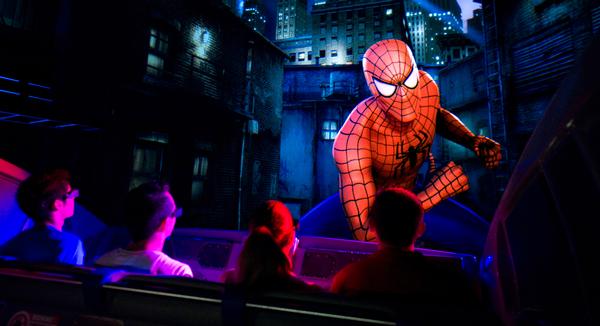
The Amazing Adventures of Spider-Man is a 3D dark ride at Universal’s Orlando and Osaka parks
PHOTO: Universal Orlando PHOTO: Universal Orlando
|
|
|
Some of the attractions industry’s brightest and most respected minds have shared their thoughts on the creative process and challenges involved with turning some of the world’s most popular IPs into real-life places. Examining how fantasy worlds such as Pandora – The World of Avatar and The Wizarding World of Harry Potter progressed from fiction to reality, Universal’s Thierry Coup and Disney’s Joe Rohde and Scott Trowbridge shared personal and professional insights at November’s IAAPA Expo with an audience of next-gen creators, operators and leaders.
|
|
Joe Rohde
Executive designer and
vice president of creative
Walt Disney Imagineering

Joe Rohde, executive designer and vice president of creative at Walt Disney Imagineering, recently launched Pandora at Animal Kingdom in Orlando, Florida.
Revealing his secrets to building and telling stories in theme parks, Rohde says that to successfully use an IP, attractions creators must put visitors at the centre of their own immersive fantasy world.
“We build story worlds, not necessarily story plots,” says Rohde, explaining the differences between using an IP in a theme park with using an IP in the movie theatre.
“A film is a format that allows you to explore the character-based side of the storytelling world. You follow characters through a plot for about 90 minutes. What we do is much more about direct experiences – what could and is going to happen to you inside this world where things also happened to those characters.”
According to Rohde, who joined Walt Disney Imagineering in 1980 during the development of Epcot, the main trap that attractions creators can fall into when working with a film IP is managing to recreate a world but failing to include that visitor as an active part of that world.
“When you go into a theatre to watch a movie you’re rendered pretty much inert,” he says. “You sit in the dark, in the quiet, and you watch something happen to somebody else. A lot of our emotional attachment to the story comes from the things that happen to this person. But it takes time. It’s not done in the first two minutes like it might be in a theme park; it’s done over an hour-and-a-half.
“When I go into a theme park, I’m up on my feet, my body is moving though space either of my own volition or in a vehicle. In the theme park, I’m anything but inert. I don’t have the spare mental framework to pay attention to what’s happening to some other person, I’m paying attention to what’s happening to me.
“The whole meaning of the story has to turn upside-down. We have to figure out what it is about this world that could ever be meaningful to a person who is experiencing it directly happening to them.”
One key thing, according to Rohde, that can make or break an IP is originality. Building an attraction exactly as its seen on film can be a success. However, creating an attraction based on elements distinctly linked to that IP but that have never been seen before, could prove more fruitful.
“In the case of Pandora – The World of Avatar, I would be hard pressed to come up with an object, character or form that you saw in the actual movie,” Rohde says.
“Nothing I can think of is copied from that film – not a rock, not a plant, even the particular Na’vi characters you meet. It’s exceedingly compelling and convincing if you accept it as a world instead of a film.
“We have a land at Animal Kingdom called Africa. There was a movie shot in Africa called Africa, but when I go to Africa, I don’t expect to see Meryl Streep because I understand that Africa is a place where you can go to make a movie. In the same sense, Pandora is a place where you can go to make a movie. Our piece of Pandora is not where that movie was made. It’s world building, which helps to increase your storytelling opportunities instead of a basic retelling of an existing film.”
| |
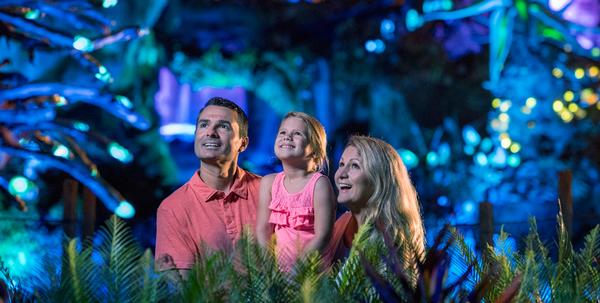

|
| Rohde led the creation of Pandora – The World of Avatar at Disney’s Animal Kingdom, a project which took six years to complete |
| |
| |
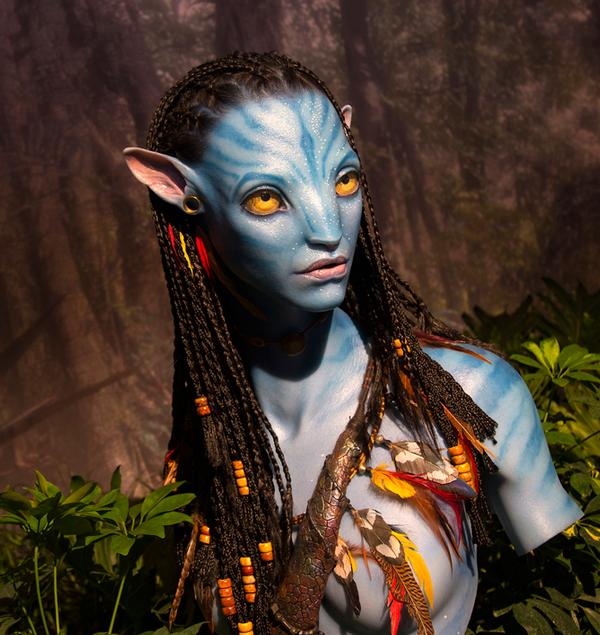

|
| Rohde led the creation of Pandora – The World of Avatar at Disney’s Animal Kingdom, a project which took six years to complete |
| |
|
|
Thierry Coup
Senior vice president
Universal Creative

Leading creative development for Universal Parks and Resorts globally, Thierry Coup, senior vice president at Universal Creative, has spent more than two decades working for the company.
Coup – who has worked on Universal projects including The Wizarding World of Harry Potter, The Amazing Adventures of Spider-Man, Transformers: The Ride and Skull Island: Reign of Kong – believes that operators looking to stay ahead of the curve must go above and beyond to deliver entirely new levels of immersive experiences unseen before by the public.
Following successes such as Universal’s Harry Potter worlds, public expectations are higher than ever and attractions must live up to them, according to Coup.
“We have to deliver experiences that are much more immersive than anything you can find out there,” he says. “You can use technologies like VR or AR, but there’s nothing like entering a world where you feel like you have been transported completely. It’s not just about igniting the basic senses like touch and sound.”
For the Wizarding World of Harry Potter attraction – first opened at Islands of Adventure in Orlando and then replicated at Universal’s parks in Los Angeles, California, and Osaka, Japan – Coup described how multi-sensory design was integral.
“You walk into the Wizarding World and you can smell things coming from the restaurant and it feels very much the way it was described in JK Rowling’s books. She did such a great job of describing every one of the senses. When you finally taste the Butterbeer, it’s like a system of engaging everything and placing you in a world that you can’t find anywhere else but there.”
There are, of course, challenges when it comes to IP collaboration, which Coup describes as “almost like marrying someone for their wonderful child”.
“You have to get along, you have to develop this relationship, but the goal is to ensure together that this ‘child’ is successful,” he says. “That comes with a lot of complexity from the partner, but there are many great things that come with that.
“For Harry Potter it was small shops, small stores, no marquees, no signage, small entrances – it goes against all the rules we have set for the perfect operating theme park. We learned from that and we were very open. We had to be.
“For the Transformers ride, we were working with Michael Bay. We told him slow-motion won’t work on a ride, but then we tried it and it was actually a great success.
“You have to make compromises. You have to learn as much as you can about where the IP came from and was born from. You have to put your ego away and both sides have to speak to each other. It becomes a crazy great marriage and you end up with this amazing final product.”
Another challenge is involving a wider audience perhaps not familiar with an IP.
“Within the theme park setting, you can’t design something just for the fans,” says Coup. “You have to make sure that you have a very compelling story, with transportive, inviting environments. For example, when we created the Spider-Man ride at Universal in 1999, none of the films had yet been released. We had to adapt Spider-Man and bring the story to life in a way that didn’t even exist yet.
“Whether you’re a fan or not, I think that the surprise of Spider-Man jumping on your car and taking you on this journey appealed to anyone on the ride.
“The worlds we create come to life and bring you into them. No matter whether you work in our industry or not, or are a fan of a particular property or not, within seconds you stop trying to analyse it because you’re drawn into the experience. That requires very careful design and crafting.”
| |
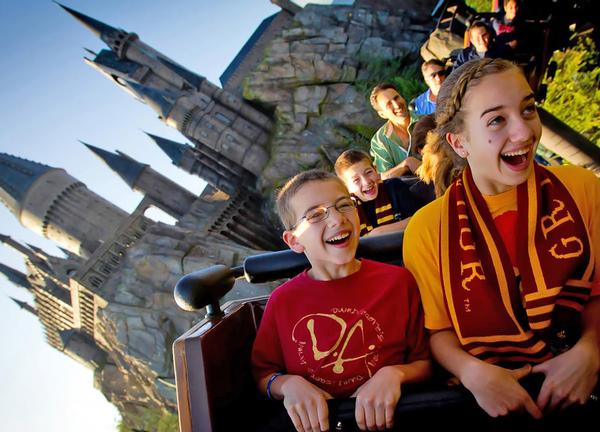

|
| PHOTOS: Universal Studios |
| Visitors at the Wizarding World of Harry Potter at Universal Studios Hollywood in Los Angeles, California |
| |
| |
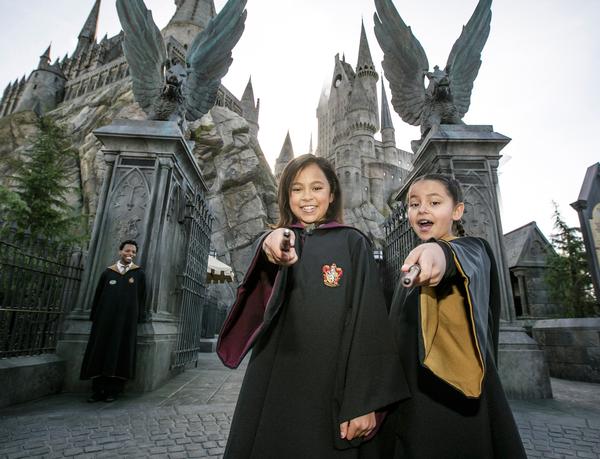

|
| PHOTOS: Universal Studios |
| Visitors at the Wizarding World of Harry Potter at Universal Studios Hollywood in Los Angeles, California |
| |
|
|
Scott Trowbidge
Creative portfolio executive
Walt Disney Imagineering

Disney Imagineer and creative lead for the theme parks’ Star Wars projects Scott Trowbridge says that attractions developers cannot take one format and paste it on to another expecting great results. Instead, an IP must be broken down and built back up in a format that is appropriate for a visitor experience.
“It’s not about taking one medium designed for something else and then trying to shoehorn that into another medium,” Trowbridge says. “A successful use of IP is to take the essence of what made that story or creative work successful, understand its DNA and then find the best possible way to express that DNA through a creative medium.”
Talking about the immersive Star Wars: Galaxy’s Edge lands under construction at Disneyland California and at Disney’s Hollywood Studios in Orlando and opening in 2019, Trowbridge says the additions will “change the lens” on who is the protagonist in the theme park experience – something that Disney wants to apply to all of its projects going forward.
“You go into traditional theme park experiences and you’re kind of invisible. With Pirates of the Caribbean, you ride it, but the pirates don’t acknowledge you.”
Trowbridge, who has the task of taking the work of Star Wars creator George Lucas and translating it into a physical world, wants to do more than just recreate famous scenes from the franchise. Instead, he is creating something completely new and distinctly Star Wars, placing visitors right at the heart of the immersive story, which plays out over multiple days to encourage repeat visits.
“It would have been easy to tell you Luke’s story on Tatooine – an iconic scene from the first movie – but we know those scenes and we know Luke’s story. We know we’re not in that story and we have no business being on that planet with Luke as some kind of weird voyeur,” he says.
“Instead what we want to do is create this universe, laying out and introducing new stories, characters and places, and to include you in these stories should you want to take part. There’s no obligation to do this, but there’s a significant part of our audience who want to feel more engaged and more connected to the stories they are experiencing, so we’re trying to find ways to take that and extend it to our parks.”
According to Disney, both Star Wars lands will transport guests to a never-seen-before planet, a remote trading port and one of the last stops before “wild space”. There will be two signature attractions: one allowing guests to take control of the Millennium Falcon and another that puts guests in the middle of a giant battle between the First Order and the Resistance.
“There’s an invitation to engage. There’s an invitation to play,” says the Imagineer. “Stay tuned, we’re very excited about it.”
| |


|
| PHOTO: Joshua Sudock/Disney Parks |
| Mark Hamill, aka Luke Skywalker, poses by a scale model of Star Wars |
| |
| |
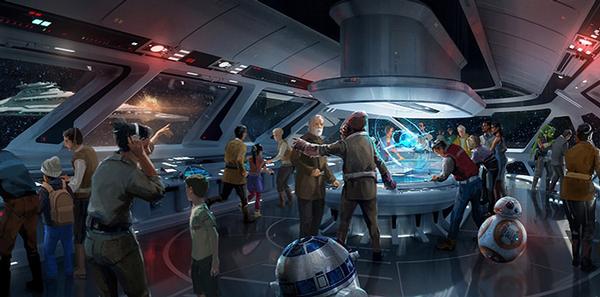

|
| PHOTO: Joshua Sudock/Disney Parks |
| Galaxy’s Edge during the D23 Expo in Anaheim, California; renderings of that project |
| |
| |
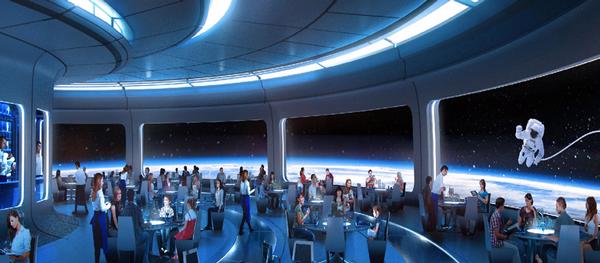

|
| Galaxy’s Edge during the D23 Expo in Anaheim, California; renderings of that project |
| |
| |
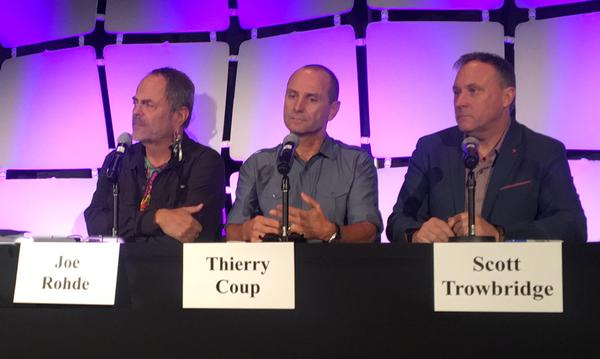

|
| Joe Rohde, Thierry Coup and Scott Trowbridge at IAAPA’s Legends panel |
| |
|
|
 |
| Originally published in Attractions Management 2018 issue 1
|
|
 |
|
